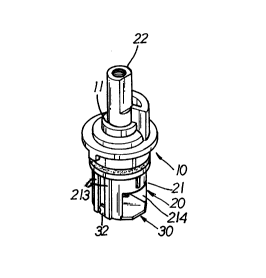Une partie des informations de ce site Web a été fournie par des sources externes. Le gouvernement du Canada n'assume aucune responsabilité concernant la précision, l'actualité ou la fiabilité des informations fournies par les sources externes. Les utilisateurs qui désirent employer cette information devraient consulter directement la source des informations. Le contenu fourni par les sources externes n'est pas assujetti aux exigences sur les langues officielles, la protection des renseignements personnels et l'accessibilité.
L'apparition de différences dans le texte et l'image des Revendications et de l'Abrégé dépend du moment auquel le document est publié. Les textes des Revendications et de l'Abrégé sont affichés :
| (12) Brevet: | (11) CA 2192763 |
|---|---|
| (54) Titre français: | OBTURATEUR POUR ROBINET MELANGEUR EAU CHAUDE/EAU FROIDE |
| (54) Titre anglais: | CONTROL VALVE FOR USE IN A DUAL HANDLED HOT/COLD WATER MIXING FAUCET |
| Statut: | Réputé périmé |
| (51) Classification internationale des brevets (CIB): |
|
|---|---|
| (72) Inventeurs : |
|
| (73) Titulaires : |
|
| (71) Demandeurs : | |
| (74) Agent: | SMART & BIGGAR |
| (74) Co-agent: | |
| (45) Délivré: | 1999-06-01 |
| (22) Date de dépôt: | 1996-12-12 |
| (41) Mise à la disponibilité du public: | 1998-06-12 |
| Requête d'examen: | 1996-12-12 |
| Licence disponible: | S.O. |
| (25) Langue des documents déposés: | Anglais |
| Traité de coopération en matière de brevets (PCT): | Non |
|---|
| (30) Données de priorité de la demande: | S.O. |
|---|
Vanne de régulation améliorée destinée à un robinet mélangeur constituée d'un support de vanne, d'un arbre de manoeuvre et d'une plaque de retenue de l'eau à deux sorties. L'arbre de manoeuvre comprend une tige et un corps de vanne à deux étages doté d'une chambre à la partie inférieure. La chambre comporte de nombreuses tiges cylindriques, incluant 4 longues et d'autres courtes qui sont placées dans un arrangement ordonné. Les tiges cylindriques sont utilisées pour diminuer le bruit associé à l'écoulement turbulent traversant le corps de la vanne, et les 4 longues tiges soutiennent la plaque de retenue de l'eau en place et empêchent un joint d'étanchéité comprimé par un ressort de tomber dans la chambre par les sorties. La tige de l'arbre de manoeuvre peut ainsi tourner avec plus d'aisance, et le bruit résultant du fonctionnement peut être réduit.
An improved control valve for use in a mixing
valve has a valve mount, a spindle assembly and a water
restraining plate having two outlets. The spindle assembly
has a spindle rod and a two staged valve body having a
chamber at the lower portion thereof. In the chamber are
there a plurality of cylindrical posts, including 4 long
posts and other short posts that are arranged in order. The
cylindrical posts are used to reduce the noise of turbulent
flow passing through the valve body and the 4 long posts
support the water restraining plate in place and stop a
spring biased sealing pad from dropping into chamber via
the outlets. Thus, the spindle rod of the spindle assembly
can be rotated more smoothly and the noise produced in
operation can be minimized.
Note : Les revendications sont présentées dans la langue officielle dans laquelle elles ont été soumises.
Note : Les descriptions sont présentées dans la langue officielle dans laquelle elles ont été soumises.

Pour une meilleure compréhension de l'état de la demande ou brevet qui figure sur cette page, la rubrique Mise en garde , et les descriptions de Brevet , États administratifs , Taxes périodiques et Historique des paiements devraient être consultées.
| Titre | Date |
|---|---|
| Date de délivrance prévu | 1999-06-01 |
| (22) Dépôt | 1996-12-12 |
| Requête d'examen | 1996-12-12 |
| (41) Mise à la disponibilité du public | 1998-06-12 |
| (45) Délivré | 1999-06-01 |
| Réputé périmé | 2005-12-12 |
Il n'y a pas d'historique d'abandonnement
| Type de taxes | Anniversaire | Échéance | Montant payé | Date payée |
|---|---|---|---|---|
| Le dépôt d'une demande de brevet | 0,00 $ | 1996-12-12 | ||
| Enregistrement de documents | 0,00 $ | 1997-03-13 | ||
| Taxe de maintien en état - Demande - nouvelle loi | 2 | 1998-12-14 | 50,00 $ | 1998-09-10 |
| Taxe finale | 150,00 $ | 1999-02-22 | ||
| Taxe de maintien en état - brevet - nouvelle loi | 3 | 1999-12-13 | 50,00 $ | 1999-10-26 |
| Taxe de maintien en état - brevet - nouvelle loi | 4 | 2000-12-12 | 50,00 $ | 2000-08-23 |
| Taxe de maintien en état - brevet - nouvelle loi | 5 | 2001-12-12 | 75,00 $ | 2001-08-24 |
| Taxe de maintien en état - brevet - nouvelle loi | 6 | 2002-12-12 | 150,00 $ | 2002-09-25 |
| Taxe de maintien en état - brevet - nouvelle loi | 7 | 2003-12-12 | 150,00 $ | 2003-10-24 |
Les titulaires actuels et antérieures au dossier sont affichés en ordre alphabétique.
| Titulaires actuels au dossier |
|---|
| CHUNG CHENG FAUCET CO., LTD. |
| Titulaires antérieures au dossier |
|---|
| KO, HSI-CHIA |